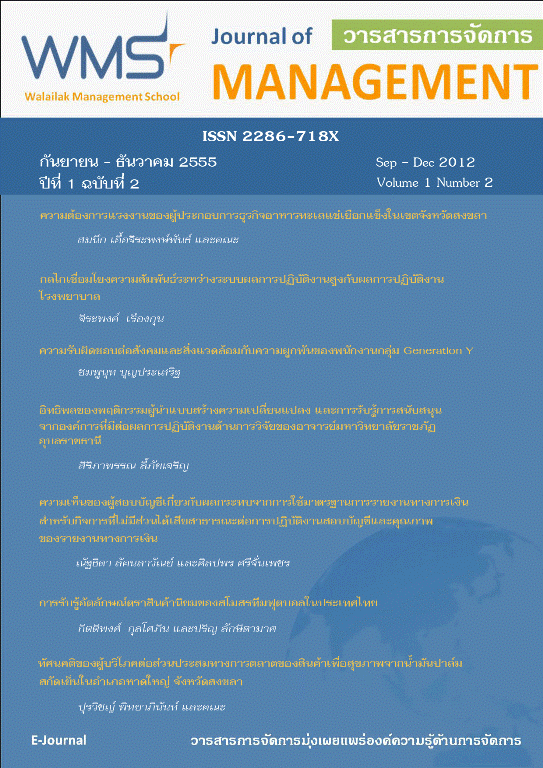Corporate Social Responsibility to Engage Generation Y Staff
Main Article Content
Abstract
The objective of this thesis was to study the effect of corporate social responsibility (CSR) approach towards employee engage in generation Y staff in a business organization. One hundred and ninety respondents were selected from an organization that focused on corporate social responsibility policy. The questionnaire survey was the selected method to collect primary data and SPSS for window was used to analyze the collected data.
The research findings showed that social responsibility activities which were positively correlated to employee engage in generation Y staff included Corporate Social Marketing, Corporate Philanthropy, Socially Responsible Business Practices, Developing and Delivering Affordable Products and Services. However, Corporate Social Marketing had the highest impact; followed by Socially Responsible Business Practices, Corporate Philanthropy, and Developing and Delivering Affordable Products and Services, respectively.Article Details
References
หนังสือ
Bloom B.S. (1956). Taxonomy of Education Objective; Handbook I: The Cognitive Domain .New York: David McKay.
Kit Yarrow and O’Donnell. (2009). Gen BuY: How Tweens, Teens and Twenty-Somethings Are Revolutionizing Retail , San Francisci.
McShane L. Stephen and Gilnow V. Mary. (2000). Organization Bahavior.Boston: Irwin McGraw-Hill.
Robbins P.S. (2005). Essential of Organization Behavior. New Jersey: Prentice Hall.
Steer, Richard M. (1977). Antecedents and outcomes of organizational commitment. Administrative Science Quarterly 22(8), 46.
Shephard Kerry. (2008). Higher Education for Sustainability: Seeking affective learning outcomes. International Journal of Sustainability in Higher Education, 9, 87-98.
Strauss, W., & Howe, N. (1991). Generations: The history of America’s future, 1584-2069. New York, NY: William Morrow and Company, Inc.
Yamane Taro. (1967). Elementary Sampling Theory. Englewood Cliffs, N.J:Prentice-Hall.
ธงชัย สันติวงศ์. (2540). องค์การและการจัดการทันสมัยยุค โลกาภิวัตน์ (พิมพ์ครั้งที่1). กรุงเทพฯ: โรงพิมพ์ไทย วัฒนาพานิช.
ฟิลิป คอตเลอร์ และแนนซี่ ลี. (2551). บรรษัทภิบาล (ความ รับผิดชอบต่อสังคมขององค์การ) ทำการกุศลเพื่อ ภาพลักษณ์องค์กรและตอบสนองประเด็นสังคม. แปล โดย รมณียฉัตร แก้วกิริยา.กรุงเทพฯ: บริษํท ยูนิเวอร์แซล พับลิซิ่ง จำกัด.
ภรณี (กีร์ติบุตร) มหานนท์. (2529). การประเมินประสิทธิผล ขององค์กร.กรุงเทพฯ: โอเดียนสโตร์.
วารสาร
Angle, H.L. and J.L.Perry. (1981). An Empirical Assessment of Organizational Commitment and Organizational Effectiveness. Administrative Science Quarterly. 26: 1-14.
Mathieu, J.E. and Zajac, D.M. (1990). A review and meta- analysis of the antecedents,correlated and consequences of organizational commitment.Psychological Bulletin. 108: 171-194.
Porter,L.W. (1974). Organizational Commitment, Job Satisfaction and Turnover Among Psychiatic Technicians. Journal of Applied Psychology. 59: 603-609.
Whitey, Michael J. and Cooper, William H. (1989). Predicting Exit, Voice, Loyalty, and Neglect. Administrative Science Quarterly. p.521-539.
จิรประภา อัครบวร. (2554). ภาพรวมการบริหารทรัพยากร บุคคลปี 2553และแนวโน้มในอนาคต, มหิดลสาร ปีที่ 36. 1: หน้า 10 -11.
สุรัสวดี สุวรรณเวช. (2549). การสร้างรูปแบบความผูกพันของ พนักงานต่อองค์กร. วารสารข้าราชการ. 51(3), 9-12.
วิทยานิพนธ์
ธัชสร บันดาลชัย. (2554). การพัฒนาทรัพยากรมนุษย์เชิงพุทธ กับความรับผิดชอบต่อสังคมอย่างยั่งยืนขององค์การ. วิทยานิพนธ์บริหารธุรกิจมหาบัณฑิต, มหาวิทยาลัยธรรมศาสตร์, คณะพาณิชยศาสตร์และ การบัญชี.
บัณฑิตา ทรัพย์กมล. (2543). ความรับผิดชอบต่อสังคมของ องค์การภาคธุรกิจ: ศึกษาเฉพาะกรณีนิคม อุตสาหกรรม เขตพื้นที่กรุงเทพมหานคร. วิทยานิพนธ์มหาบัณฑิต, มหาวิทยาลัยธรรมศาสตร์, คณะสังคมสงเคราะห์ศาสตร์.
ภัทรพล กาญจนปาน. (2552). จริยธรรมในองค์กรที่มีผลต่อ ความผูกพันต่อองค์กรของพนักงานและผลการดำเนินงาน ของการประปานครหลวง. วิทยานิพนธ์มหาบัณฑิต, มหาวิทยาลัยศรีนครินทรวิโรฒ,สาขาวิชาการจัดการ.
วิภาดา วีระสัมฤทธิ์. (2553). ความรับผิดชอบต่อสังคมของ องค์กร (CSR) ที่มีผลต่อความจงรักภักดีของลูกค้า: บริษัท แอดวานซ์ อินโฟร์ เซอร์วิส จำกัด (มหาชน). วิทยานิพนธ์บริหารธุรกิจมหาบัณฑิต,มหาวิทยาลัย ศรีนครินทรวิโรฒ, คณะบริหารธุรกิจ.
วิมล จันทร. (2552). ความคิดเห็นของพนักงานต่อกิจกรรม ความรับผิดชอบต่อสังคม บริษัทแปลนครีเอชั่นส์ จำกัด. วิทยานิพนธ์สังคมสงเคราะห์ศาสตร์มหาบัณฑิต, มหาวิทยาลัยธรรมศาสตร์, คณะสังคมสงเคราะห์ศาสตร์.
สื่ออิเล็กทรอนิกส์
Bruce Tulgan, Carolyn A. Martin. (2001).Managing Generation Y. Retrieved 14 July ,2011, from http://books.google.co.th/books?id=ymycEFOXht oC&printsec=frontcover&hl=th&source=gbs_g e_summary_r&cad=0#v=onepage&q&f=false.
Crealock Martha. (2008). This issue’s topic is the Millennials. There has been a lot of talk about
Millennials or Generation Y. Retrieved 6 July 2011, from www.usask.ca/gmcte/drupal/files/bridges_Jan08. pdf.
Hewitt Associate. (2003). Employee Engagement. Retrieved 14 July 2011, from http://www.hewitt.com.
Joel Mitch. (2010). Social Media a Waste of Time? Not to Generation Y. Retrieved 6 July 2011, from http://www.vancouversun.com/business/technolo gy/Social+media+waste+time/3669581/story.html
Jeanne C. Meister and Karie Willyerd.(2010).Mentoring Millennials.Harvard Business Review. Retrieved 6 July 2011, from http://hbr.org/2010/05/mentoring-millennials/ar/1.
McCrindle, Mark (2005). Superannuation and the Under 40’s: Summary Report: Research Report on the Attitudes and Views of Generations X and Y on Superannuation. Retrieved 6 July 2011, from www.aph.gov.au/house/committee/efpa/super/su bs/sub002.pdf.
National Master. (2553). Thailand Population Pyramid for 2010. Retrieved 20 June, 2011 from http://www.nationmaster.com/country/th/Age_distr ibution.
Peter Sheahan. (2005). Generation Y blog. Retrieved 20 June ,2011 from http://generationy.typepad.com/petersheahan/gen _y_retention/.
Stephanie Armour (2005). Generation Y: They've arrived at work with a new attitude. Retrieved 20 June ,2011 from http://www.usatoday.com/money/workplace/2005- 11-06-gen-y_x.htm.
Tiffany Monhollon. (2007). GenerationY Style. Retrieved 3 September, 2011,from http://littleredsuit.com/2007/07/19/from-corporate- social-responsibility-to-personal-social- responsibility/.
The Australian Bureau of Statistics. (2010). Understanding the Different Generations and Their Characteristics. Retrieved 3 September, 2011,
from http://jojackson.suite101.com/veterans- baby- boomers-gen-x-gen-y-and-gen-z- a185353.
จุฬาลงกรณ์ธุรกิจปริทัศน์ฉบับล่าสุดของวันนี้. ปีที่ 31. ฉบับที่ 119-120 มกราคม – มิถุนายน 2552. สืบค้นเมื่อวันที่ 20 มิถุนายน 2554, จาก http://www.oknation.net/blog/librarian-in- marketing/2009/07/30/entry-1.
พสุ เดชะรินทร์. (2552). การทำความเข้าใจกับคน Generation Y. สืบค้นเมื่อวันที่ 22 มิถุนายน 2554, จาก http://www.wiseknow.com/blog/2009/08/31/3289/.
วรัญญา ศรีเสวก. (2553). เหตุผลที่ไม่มีเหตุผลของคน Generation Y. สืบค้นเมื่อวันที่ 20 มิถุนายน 2554, จาก
http://www.wiseknow.com/blog/2009/08/31/3289/.
ศิริยุพา รุ่งเริงสุข. (2553). HR แห่งอนาคต. สืบค้นเมื่อวันที่ 20 มิถุนายน 2554, จาก http://www.manager.co.th/mgrweekly/viewnews.a spx?NewsID=9530000145414.
เสาวนีย์ พิสิฐานุสรณ์. (2550). Generation Y ตบเท้าเข้าสู่โลก ธุรกิจ. สืบค้นเมื่อวันที่ 17 กรกฎาคม 2554, จาก http://www.artgazine.com/shoutouts/viewtopic.ph p?t=1546.
เอกสารประกอบอื่นๆ
สุทธิศักดิ์ ไกรสรสุทธาสินี. (2554). เอกสารประกอบการบรรยาย Corporate Governance and Social Responsibility. ในมหาวิทยาลัยธรรมศาสตร์, คณะพาณิชยศาสตร์และการบัญชี. กรุงเทพฯ: ผู้แต่ง.


